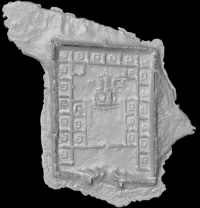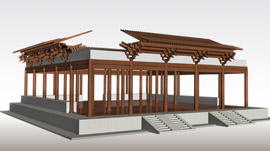 Tuvan scientist brought forth a hypothesis that the fortress Por-Bazhyn on an island in lake Tere-Khol, which is one of the entries in the “Nine Treasures” contest, served as an observatory. Tuvan scientist brought forth a hypothesis that the fortress Por-Bazhyn on an island in lake Tere-Khol, which is one of the entries in the “Nine Treasures” contest, served as an observatory.
Candidate of physical – mathematical sciences, Dadar-ool Dan-Syuryun is convinced that the round pottery discs, which the researchers of the Por-Bazhyn fortress call “ornamental tiles”, are nothing else but a schematic depiction of the structure of a solar-lunar calendar of ancient Turk nomads – ancestors of Tuvans.
 They used this scheme to construct a calendar with five-year cycles, similar to the one which we use today. They used this scheme to construct a calendar with five-year cycles, similar to the one which we use today.
Everything started from watching video-material filmed by tourists in the ruins of the fortress. One of them is holding a round object – the end-dics of a tile ornament it shows some kind of picture. Maybe, the tourist concludes, this is some sort of an ornament presented 14 centuries ago to the Chinese princess.
- I was struck by the practicality of the symmetry of the “ornament”, - says Dadar-ool Dan-Syuryun.- It shows three concentric circles. Inside of the central, innermost one, there are seven circles located at equal distance from each other and from the center. The middle consists of alternating circles and triangles; there are 16 of them, 8 circles and 8 triangles. The outer circle consists of 28 small circles symmetrically disposed, which correspond to 28 solar days. By the outermost circle, the calendar refers to the Earth’s revolutions around the Sun. according to this calendar, one month consisted of either 29 or 30 days. These days of the month are not depicted on the calendar, but they are calculated using the middle and the central circles. By the middle circle, the calendar refers to the Moon’s revolutions around the Earth. The eight circles of the middle circle correspond to the eight phases of the moon. The eight triangles of this circle mark the solar days of the month. These markers of time show how many days to add to the 28 days of the month - one or two.
 The central, innermost circle shows the Earth’s rotations around its axis, tied to the phases of the moon. The time period of one quarter of the Moon’s revolution is about 7 days. Consequently, the seven small circles of the central circle correspond to seven solar days. The central, innermost circle shows the Earth’s rotations around its axis, tied to the phases of the moon. The time period of one quarter of the Moon’s revolution is about 7 days. Consequently, the seven small circles of the central circle correspond to seven solar days.
This is the way this calendar works: An imaginary line is drawn through two diametrically opposite triangles, that is, through two markers. If the line transects one of the inside circles, one day is added to 28; if it transects two circles, two days are added.
The result is that the ancient nomads considered 28 days to be a permanent constant of one month. The calendar year itself - 354 solar days – has 12 months. According to the idea of the ancient scholars who calculated this calendar, the year has 360 days; half a year of 29 day months and half a year of 30 day months. The calendar works in 5-year cycles, because the periods of the Moon’s revolutions around the Earth and the Earth’s revolutions around the Sun coincide in approximately 5 years.
- And why was the fortress built in the middle of the lake?
- The most important characteristic of lake Tere-Khol is its smooth, mirror-like surface. From the height of about 10 meters, you can easily see that its calm, mirror-like surface reflects the sun, moon and the stars as well as the trajectories of their movement. This natural system allows the study of the dynamics of the movements of celestial bodies with sufficient accuracy. So one can say with a great deal of confidence that Por-Bazhyn was built specifically for the purpose of study of these movements. The grandiosity of the building, the unique floor plan of the interior rooms, in conjunction with the celestial sphere makes it possible to confirm this courageous idea that Por-Bazhyn is the largest observatory of the nomadic civilization of ancient Turks.
 This idea of the scholar is supported by the legend “Elchigen-Syrgalyg Khan”, which is told by Tere-Khol local residents. It tells how the Khan who lived in Por-Bazhyn, one day was looking around the area with his binocular made of black metal. Through this implement, he could see the nine most distant mountaind of Tandy. In Dadar-ool Dan-Syuryun’s opinion, this binocular was most likely an astronomical instrument – a sextant. This idea of the scholar is supported by the legend “Elchigen-Syrgalyg Khan”, which is told by Tere-Khol local residents. It tells how the Khan who lived in Por-Bazhyn, one day was looking around the area with his binocular made of black metal. Through this implement, he could see the nine most distant mountaind of Tandy. In Dadar-ool Dan-Syuryun’s opinion, this binocular was most likely an astronomical instrument – a sextant.
He most likely, was standing on the roof of one of the buildings of Por-Bazhyn.
|
